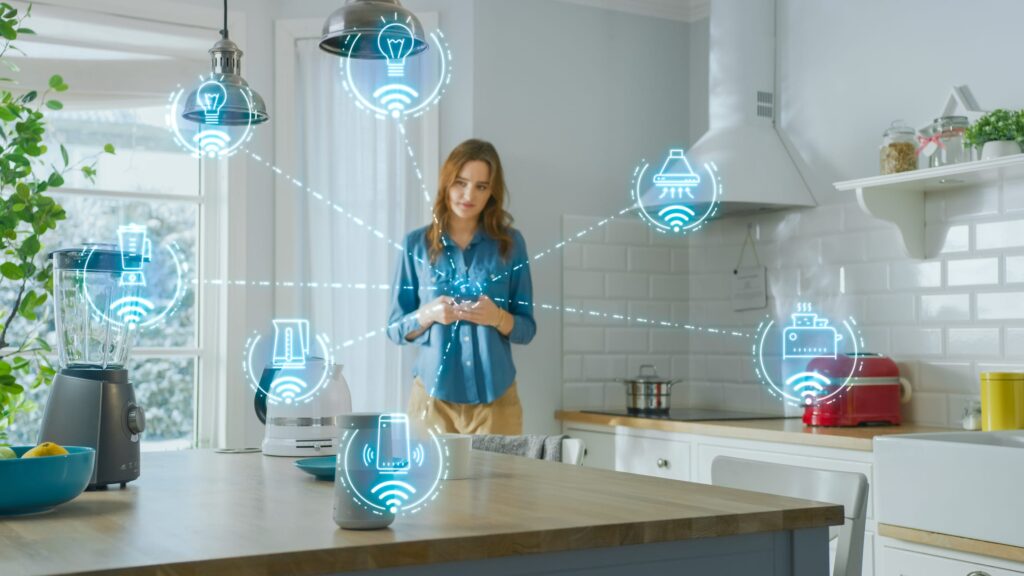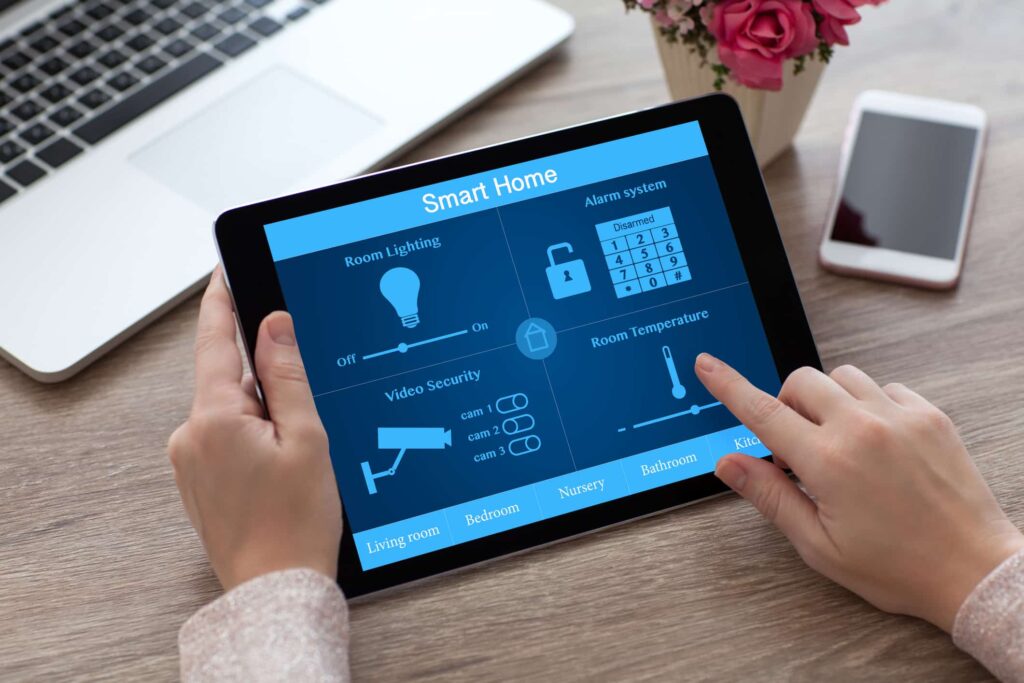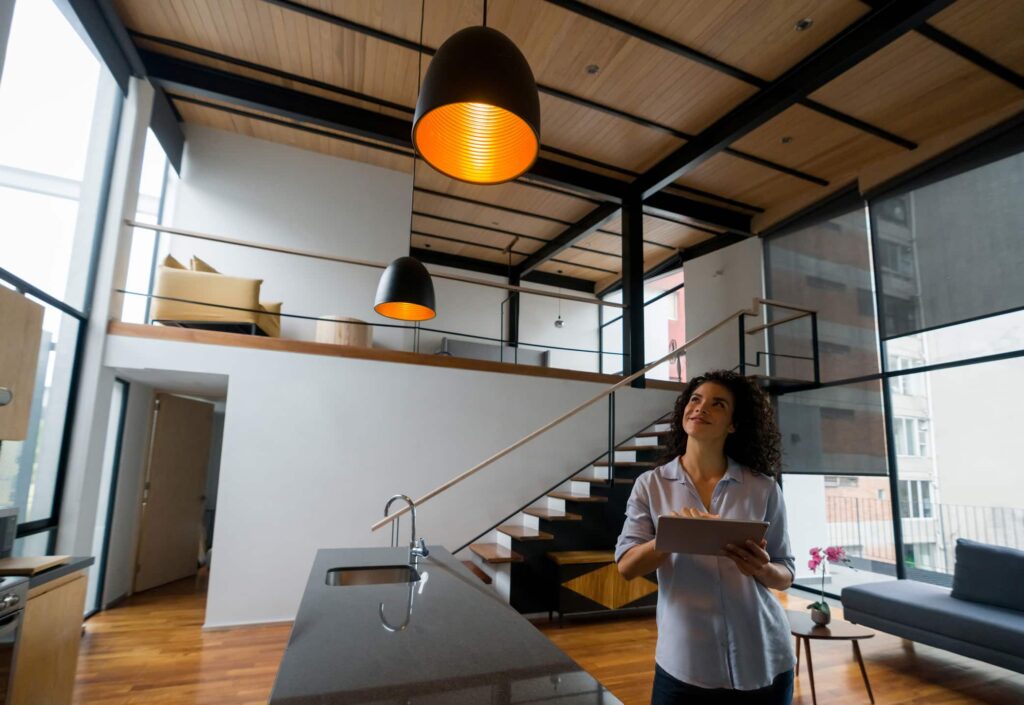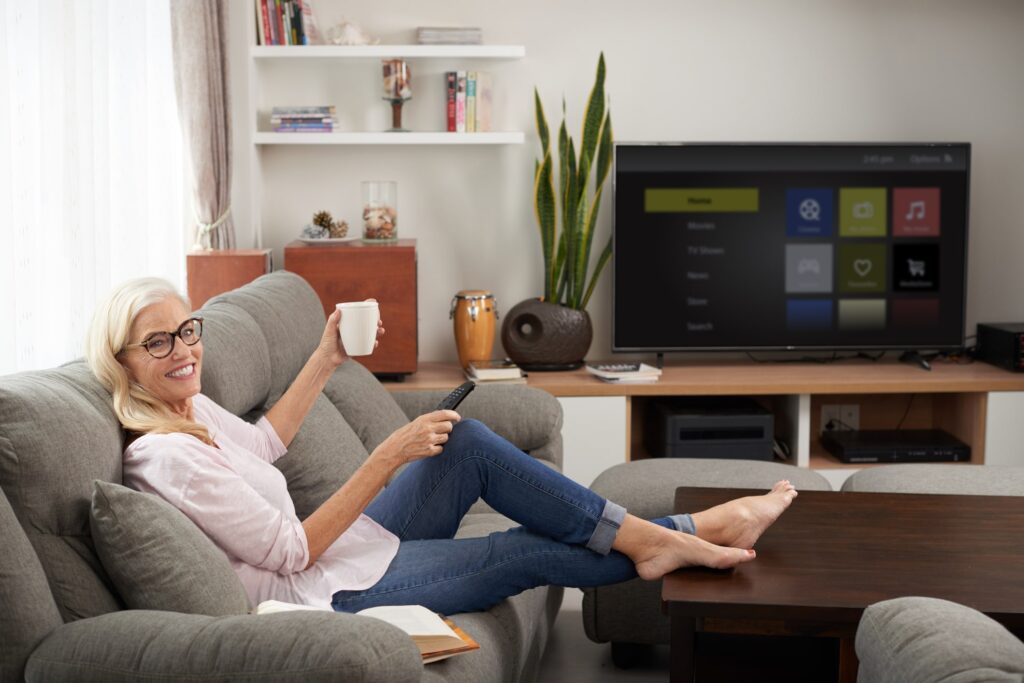
Picture this: You’re rushing out the door, already late for work, when suddenly your home chimes in, “Don’t forget your keys, Dave!” Sounds like a scene straight out of a sci-fi movie. Welcome to the era of smart homes, where such conveniences are possible and increasingly becoming the norm.
In this article, we’re diving headfirst into smart home technology, exploring the latest innovations that promise to revolutionize our lives. From futuristic appliances to energy-saving solutions and state-of-the-art security systems, we’ll explore the most used smart home automation ideas and cutting-edge “Smart Home Ideas of 2024.”
Get ready to discover a world where convenience, comfort, and innovation converge to create an experience unlike any other
Table of Contents
What is Smart Home Technology?
In the not-so-distant past, homes were static structures, bound by brick and mortar and the limitations of their manual efforts. But oh, how times have changed! Today, we stand on the cusp of a technological revolution that transforms our homes into something straight out of a sci-fi fantasy – welcome to the smart home technology.
At its core, smart home technology is all about connectivity, convenience, and control. It’s the art of infusing everyday objects with intelligence, allowing them to communicate, automate tasks, and adapt to our needs with minimal human intervention. Think of it as having a personal assistant for your home—one that’s always on, always learning, and always ready to help.
But how did we get here? The evolution of smart homes traces back to the advent of the internet and the proliferation of connected devices. What started with simple, smart gadgets like smart thermostats and programmable coffee makers has blossomed into a full-fledged ecosystem of interconnected appliances, sensors, and systems.
Today, smart home technology encompasses a dizzying array of devices and platforms, each vying for a slice of the burgeoning market. The possibilities are virtually limitless, from voice-controlled assistants like Alexa and Google Assistant to smart locks, lights, and refrigerators.
And the best part? We’re only scratching the surface. As technology continues to advance at breakneck speed, so too do the capabilities of smart homes. Imagine a future where your home responds to your commands and anticipates your needs before you even utter a word. It’s a tempting prospect that promises to make our lives easier, more efficient, and ultimately, more enjoyable.
Lifestyle & Convenience Automation
Wake Up Refreshed
Start your day with automated wake-up routines that gently rouse you from slumber. Set your smart home to increase the lights gradually, adjust the thermostat to your preferred temperature, and even brew your morning coffee so it’s ready when you enter the kitchen.
Effortless Entertaining
Hosting a dinner party? Let your smart home handle the details. With voice commands, you can set the perfect ambiance with lighting presets, adjust the temperature for guest comfort, and even queue up a curated playlist to set the mood.
Stay Secure, Stay Safe
Never worry about your home’s security again. Smart locks and security cameras offer peace of mind by allowing you to monitor and control access to your home from anywhere. Receive instant alerts and live video feeds directly to your smartphone, ensuring your home is always protected.
Hands-Free Convenience
Embrace hands-free convenience with voice-controlled automation. To adjust lights and thermostats, play music, or check the weather, speak commands to your smart assistant and watch as your home springs into action.
Efficient Energy Management
Smart energy management systems can save energy and reduce utility bills. They monitor energy usage in real-time, identify areas for improvement, and automate energy-saving routines to optimize efficiency without sacrificing comfort.
Seamless Integration
Enjoy the convenience of seamless integration with your favorite smart devices and platforms. Whether controlling your smart home from a smartphone app or using voice commands with a virtual assistant, compatibility across devices ensures a cohesive and intuitive experience.
Remote Access
Stay connected to your smart home control panel, no matter where life takes you. With remote access capabilities, you can control your smart home devices from anywhere with an internet connection, giving you peace of mind and flexibility.
By incorporating these lifestyles and the convenience of home automation ideas into your home, you’ll experience firsthand the transformative power of smart technology in simplifying and enhancing your daily routine. With a smart home tailored to your needs, say goodbye to tedious tasks and hello to a life of effortless convenience.
Smart Appliances Ideas

1. Smart Fridge:
In 2024, smart fridges are more intuitive than ever. They utilize AI algorithms to suggest recipes based on available ingredients and dietary preferences.
A smart fridge with features like internal cameras, inventory tracking, and automatic expiration notifications will keep your groceries fresh and your kitchen organized.
Benefits of Smart Fridge:
- Save Time: Smart refrigerators streamline meal planning and grocery shopping, saving valuable time by tracking inventory and suggesting recipes based on available ingredients.
- Save Money: By reducing food waste and helping you make the most of your groceries, smart fridges can save you money in the long run. Say goodbye to spoiled produce and forgotten leftovers, and hello to a more efficient kitchen.
- Save Energy: Smart refrigerators are designed with energy-saving features that help reduce electricity consumption. This contributes to lower utility bills and a more eco-friendly home.
2. Smart Vacuum Cleaner:
Say goodbye to manual vacuuming with a smart vacuum cleaner that navigates your home autonomously, mapping out the most efficient cleaning routes and avoiding obstacles in real-time. In 2024, smart vacuum cleaners will boast enhanced suction power, longer battery life, and advanced sensor technology for improved performance on all surfaces.
Relax, as your smart vacuum does the dirty work for you. With customizable cleaning schedules and app-controlled operation, keeping your floors clean has never been easier.
Benefits of Smart Vacuum Cleaners:
- Effortless Cleaning: Say goodbye to tedious vacuuming sessions with a smart vacuum cleaner. Its automated cleaning features allow you to enjoy a cleaner home with minimal effort, freeing up your time for more enjoyable activities.
- Versatile Cleaning: Whether it’s pet hair, dust, or debris, smart vacuums are equipped to tackle messes of all sizes and surfaces. This ensures your floors are spotless and your home is always presentable.
- Healthier Home: With regular cleaning schedules and powerful suction capabilities, smart vacuum cleaners help remove allergens and pollutants from your home, contributing to a healthier indoor environment for you and your family.
- Convenient Control: You can remotely control your smart vacuum cleaner using smartphone apps or voice commands. This allows you to start, stop, or schedule cleaning sessions from anywhere, ensuring your home stays clean even when you’re away.
3. Smart Coffee Maker:
In 2024, smart coffee makers offer even greater control and convenience, with voice-activated brewing, personalized drink presets, and automatic reordering of coffee supplies.
Start your day with a smart coffee maker that brews your favorite blend to perfection at the touch of a button. Whether you prefer a bold espresso or a creamy latte, your smart coffee maker delivers the perfect cup every time, tailored to your specifications.
Key Benefits of Smart Coffee Makers:
- Barista-Quality Coffee: Experience the luxury of barista-quality coffee in the comfort of your own home. With precise temperature control and customizable brewing options, smart coffee makers always deliver exceptional taste and aroma.
- Time Savings: Say goodbye to long lines and waiting at the coffee shop. With a smart coffee maker, you can brew your favorite coffee drinks at home, saving time and eliminating the need for frequent trips to your local cafe.
- Customization: With customizable brewing options, you can tailor your coffee exactly to your liking. Whether you prefer a strong espresso or a creamy latte, smart coffee makers allow you to adjust settings like brew strength, temperature, and milk frothing to suit your taste preferences.
4. Smart Air Purifier:
In 2024, smart air purifiers will leverage advanced filtration technology and AI algorithms to control indoor air quality precisely, detecting and addressing potential contaminants with unparalleled accuracy.
Create a healthier home environment for you and your loved ones with a smart air purifier that prioritizes your health and comfort. From reducing allergy symptoms to eliminating pet odors, you’ll notice the difference in air quality from the moment you turn it on.
Key Benefits of Smart Air Purifiers:
- Cleaner Indoor Air: Experience cleaner, fresher air in your home with the advanced filtration capabilities of a smart air purifier. Remove airborne pollutants, allergens, and odors, creating a healthier environment for you and your family to breathe.
- Improved Health: Cleaner air helps you breathe easier and sleep better. Smart air purifiers help reduce respiratory irritants and allergens, minimize allergies and asthma symptoms, and promote overall wellness.
- Peace of Mind: You can enjoy peace of mind knowing that your home is protected against harmful pollutants and contaminants. With real-time air quality monitoring and automatic purification adjustments, smart air purifiers provide continuous protection against airborne threats.
- Convenience: Experience the convenience of intelligent air purification technology. With features like remote control, scheduling, and filter replacement alerts, smart air purifiers make it easy to maintain optimal indoor air quality without constant monitoring.
Smart Home Energy Saving Device

Solar-Powered Devices:
Solar power technology continues to advance rapidly. In 2024, more efficient solar panels and integrated energy storage solutions will become increasingly accessible and affordable.
Examples of Solar-Powered Devices:
- Solar Panels: Photovoltaic (PV) solar panels convert sunlight into electricity, providing a renewable energy source for powering homes, businesses, and other applications.
- Solar Water Heaters: Solar water heaters use solar energy to heat water for domestic use, such as bathing, washing dishes, and laundry. They can be installed on rooftops or in other sunny locations to maximize energy capture.
- Solar Lights: Solar-powered outdoor lights charge photovoltaic cells during the day and illuminate outdoor spaces at night. They are commonly used for landscaping, pathway lighting, security lighting, and decorative purposes.
- Solar Chargers: Solar chargers harness solar energy to recharge batteries or power electronic devices such as smartphones, tablets, cameras, and portable speakers. They are convenient for outdoor activities, camping trips, and emergencies.
- Solar Backpacks: Solar-powered backpacks feature built-in solar panels that can charge electronic devices while on the go. They are ideal for outdoor enthusiasts, travelers, and students who need to stay connected without access to electrical outlets.
- Solar Fountain Pumps: Solar-powered fountain pumps use solar energy to power water pumps that create decorative water features in gardens, ponds, and outdoor landscapes. They operate without electricity or wiring, making them easy to install and environmentally friendly.
- Solar-Powered Fans: Solar-powered fans use solar energy to power ventilation fans that provide cooling relief in hot and sunny conditions. They are often used in greenhouses, RVs, boats, and off-grid cabins to improve comfort without relying on grid electricity.
Key Benefits of Solar-Powered Devices:
- Reduced Reliance on Fossil Fuels: Transitioning to solar power helps reduce dependence on fossil fuels, decrease greenhouse gas emissions, and mitigate the effects of climate change.
- Long-Term Cost Savings: Solar-powered devices offer significant long-term cost savings by generating free, renewable energy from the sun. By offsetting traditional energy usage, homeowners can lower utility bills.
- Contribution to Sustainability: Homeowners actively contribute to a more sustainable energy future by harnessing solar energy. Solar power reduces reliance on finite fossil fuel resources and promotes environmental conservation, helping to create a cleaner and greener planet for future generations.
Smart Thermostat:
Smart thermostats are equipped with smart sensors and AI algorithms to optimize indoor comfort levels. They learn your preferences and adjust temperature settings accordingly, ensuring your home is always at the perfect temperature.
Enjoy the luxury of coming home to a perfectly comfortable environment customized to your liking. With smart thermostats, you can comfortably relax, knowing that your home’s climate is tailored to your preferences.
Benefits of Smart Thermostats:
- Energy Savings: Smart thermostats optimize heating and cooling schedules based on occupancy patterns, weather conditions, and user preferences, reducing energy consumption and utility bills.
- Comfort Optimization: Enjoy personalized comfort with precise temperature control and scheduling features that ensure your home is always at the perfect temperature when needed, enhancing overall comfort and well-being.
- Remote Access and Control: You can control your thermostat remotely using smartphone apps or voice commands. This allows you to adjust temperature settings from anywhere, ensuring comfort and energy savings even when you’re away from home.
- Integration with Smart Home Systems: Smart thermostats can seamlessly integrate with other smart home devices and platforms, enabling automation and coordination with activities like lighting, security, and energy management for a more cohesive and efficient smart home ecosystem.
With a smart thermostat tailored to your lifestyle, you can experience the benefits of personalized comfort and energy efficiency.
Smart Home Security Ideas

Advanced Smart Lock:
Smart locks have evolved beyond basic keyless entry. They now offer advanced features such as biometric authentication, geofencing capabilities, and integration with smart home systems.
Never worry about forgetting your keys again or fumbling with a lock in the dark. With advanced smart lock features, you can enter your home effortlessly with a simple touch or even a glance, knowing that your home is secure.
Key Benefits of Smart Locks:
- Keyless Entry: Experience the convenience of keyless entry, eliminating the need for traditional keys and providing hassle-free home access.
- Biometric Authentication: Biometric authentication features, such as fingerprint scanning or facial recognition, enhance security and ensure that only authorized individuals can unlock your door.
- Geofencing: Utilize geofencing technology to enable automatic locking and unlocking of your door based on your smartphone’s location, adding an extra layer of convenience and security.
- Integration with Smart Home Systems: Seamlessly integrate smart locks with your existing smart home ecosystem, allowing for centralized control and monitoring of your home security from anywhere, using smartphone apps or voice commands.
- Peace of Mind: Knowing your home is secure, you can enjoy peace of mind. You can monitor access and receive real-time alerts on your smartphone, ensuring you’re always in control of who enters your home.
Other Examples of Smart Home Security Devices:
- Smart Cameras: Smart security cameras provide high-definition video surveillance of your home, allowing you to monitor activity remotely via smartphone apps. They often feature motion detection, night vision, and two-way audio communication.
- Smart Doorbells: Smart doorbell cameras combine a doorbell with a built-in camera, enabling you to see and communicate with visitors at your door from anywhere using your smartphone. They typically include motion detection, video recording, and remote access features.
- Smart Sensors: Smart sensors detect motion, door/window openings, and environmental changes in your home, triggering alerts and notifications to your smartphone. They can be used to monitor for intrusions, detect leaks/floods, and ensure the safety of your home.
- Smart Alarms: Smart alarm systems provide comprehensive security monitoring for your home, including intrusion, fire/smoke, and carbon monoxide detection. They often feature remote arming and disarming, customizable alerts, and integration with security cameras and sensors.
- Smart Smoke/CO Detectors: Smart smoke and carbon monoxide detectors send alerts to your smartphone in emergencies, allowing you to take immediate action even when you’re away from home. They may also include self-testing, voice alerts, and integration with other smart devices.
- Smart Garage Door Openers: Smart garage door openers allow you to remotely control and monitor your garage door via smartphone apps. They offer features like remote opening/closing, activity logs, and alerts for unauthorized access.
- Smart Security Hubs: Smart security hubs act as centralized control systems for your home security devices, allowing you to manage and monitor multiple devices from a single interface. They may include features like home automation integration, security camera feeds, and customizable settings.
By incorporating these smart home and security system ideas into your home, you can enjoy enhanced protection and peace of mind, knowing your home is safeguarded against potential threats.
Smart Lighting Ideas

Smart lighting systems offer unparalleled customization and control options. Users can tailor their lighting to suit any mood or occasion, from color-changing bulbs to adjustable brightness levels.
Whether you prefer warm, inviting hues or vibrant colors to set the mood, smart lighting puts the power of customization at your fingertips.
Examples of Smart Lighting:
- Smart Bulbs: Smart bulbs, such as Philips Hue, LIFX, and Sengled, can be controlled remotely using smartphone apps or voice commands. They offer features like dimming, color changing, and scheduling, allowing users to customize their lighting to suit their preferences and moods.
- Smart Light Strips: Smart light strips, like the Philips Hue Lightstrip and LIFX Z, are flexible, adhesive strips of LED lights that can be placed around furniture, under cabinets, or along walls to add ambient or accent lighting. They can be controlled and programmed using smartphone apps or voice assistants.
- Smart Light Fixtures: Smart light fixtures, such as smart ceiling lights or smart lamps, come with built-in smart technology for easy integration into a smart home ecosystem. They offer adjustable brightness, color temperature control, and compatibility with smart home platforms.
- Smart Switches and Dimmers: Smart switches and dimmers replace traditional light switches, allowing users to control their existing light fixtures remotely. They can be programmed to automatically turn lights on and off, adjust brightness levels, and create lighting schedules for energy savings and convenience.
- Outdoor Smart Lighting: Outdoor smart lighting solutions, such as smart floodlights, pathway lights, and garden lights, provide enhanced security and ambiance for outdoor spaces. They can be controlled remotely and programmed to respond to motion, sunrise/sunset times, or specific events.
- Lighting Scenes and Automation: Smart lighting systems allow users to create custom lighting scenes and automation routines. For example, users can set up “Good Morning” scenes that gradually brighten the lights in the morning or “Movie Night” scenes that dim the lights and adjust the color temperature for a cozy atmosphere.
Benefits of Smart Lights:
- Convenience: Enjoy the convenience of remote control and automation, which allow you to adjust lighting settings from anywhere using your smartphone or voice commands and schedule lighting routines to fit your lifestyle.
- Customization: Personalize your lighting experience with customizable color options, brightness levels, and lighting scenes, allowing you to create the perfect ambiance for any occasion or mood.
- Integration with Smart Home Systems: Smart lights can seamlessly integrate with other smart home devices and platforms, enabling automation and synchronization with activities like entertainment, security, and energy management.
- Longevity and Durability: Enjoy longer-lasting lighting solutions with LED smart lights. These energy-efficient bulbs have a longer lifespan than traditional incandescent bulbs, reducing the frequency of bulb replacements and maintenance costs.
Say goodbye to traditional light switches and hello to a brighter, more innovative future with smart lighting. Enjoy the freedom to customize and control your lighting, enhance the ambiance of any space, and reap the benefits of energy efficiency, all with the touch of a button.
Voice Assistant Automation Ideas

Voice assistants are the central hub for controlling various smart devices within the home. In 2024, these assistants will become even more integrated, allowing users to manage lights, thermostats, security cameras, and more, all with simple voice commands.
- Convenience: Voice assistants like Alexa, Google Assistant, and Siri allow users to perform tasks hands-free, enhancing convenience and accessibility. From adjusting settings to initiating routines, voice commands streamline daily interactions with smart home technology.
- User Experiences: Imagine waking up and saying, “Good morning,” triggering your voice assistant to turn on the lights, adjust the thermostat, and brew your morning coffee—all before you even step out of bed. With voice assistants, controlling your smart home is as easy as speaking aloud.
By centralizing control and offering creative commands, voice assistants enhance convenience and streamline daily routines, making smart home living more accessible and enjoyable.
Smart Entertainment Ideas

Smart entertainment systems have undergone significant advancements, offering immersive experiences that rival commercial theaters. These systems typically include high-definition displays, surround sound speakers, and integrated smart features.
Examples of Smart Entertainment Ideas:
- Smart TVs: Smart TVs offer access to streaming services, internet browsing, and apps directly on the television screen. They often feature voice control, personalized recommendations, and integration with smart home devices for enhanced entertainment experiences.
- Streaming Devices: Streaming devices like Roku, Amazon Fire Stick, and Google Chromecast enable access to a wide range of streaming services, allowing users to enjoy movies, TV shows, music, and more on their existing television sets.
- Smart Sound Systems: Smart speakers like Sonos and Bose SoundTouch deliver immersive audio experiences with features like multi-room audio, customizable sound profiles, and voice control, enhancing the enjoyment of music, movies, and TV shows throughout the home.
- Augmented Reality (AR) and Virtual Reality (VR) Devices: AR and VR devices provide immersive entertainment experiences, allowing users to explore virtual worlds, play interactive games, and watch immersive videos and experiences, blurring the lines between the digital and physical realms.
- Projectors and Screens: Home projectors and screens enable users to create a cinematic experience in their homes, with indoor and outdoor viewing options. They can be paired with streaming devices, gaming consoles, and sound systems for a complete entertainment setup.
By embracing smart entertainment systems, you can transform your home into a hub of entertainment and innovation. Today, experience the future of home entertainment with a smart TV system tailored to your needs and preferences.
Smart Home Health Technology

Smart home health technology enables remote monitoring of vital signs and health parameters using connected devices such as wearables, smart scales, and blood pressure monitors. These devices collect real-time data and transmit it to healthcare providers for analysis.
Smart home health technology aligns with the shifting paradigm of healthcare toward patient-centered, value-based care. It promotes proactive management of health conditions, reduces reliance on reactive treatments, and empowers individuals to participate in their care actively.
Examples of Smart Home Health Technology:
- Smart Health Monitoring Devices: Devices such as smart scales, blood pressure monitors, and glucometers can track vital health metrics and send data directly to smartphones or cloud-based platforms for real-time monitoring and analysis.
- Wearable Fitness Trackers: Fitbit, Garmin, and Apple Smart Watches monitor activity levels, heart rate, sleep patterns, and other health metrics. They provide insights into physical activity, exercise intensity, and overall health and encourage users to adopt healthier lifestyles.
- Medication Management Devices: Smart medication management devices like pill dispensers, medication reminders, and medication tracking apps help users manage their medication schedules and adhere to prescribed treatment plans. They provide reminders, refill alerts, and dosage tracking to prevent missed doses and medication errors.
- Telehealth Platforms: Telehealth platforms facilitate remote consultations and virtual healthcare services, allowing patients to access medical care from home. These platforms often include video conferencing, secure messaging, and electronic health record (EHR) integration for seamless communication and care coordination.
- Smart Home Environmental Sensors: These sensors detect indoor air quality, temperature, humidity, and other environmental factors impacting health and well-being. They provide insights into potential health risks and enable users to take corrective actions to improve indoor air quality and comfort.
- Personal emergency response systems (PERS) offer peace of mind to individuals living alone or with chronic health conditions. These systems include wearable devices, panic buttons, and fall detection sensors that alert caregivers or emergency services in emergencies or medical crises.
Benefits of Smart Home Health Technology:
- Remote Health Monitoring: Smart home health devices allow for remote monitoring of vital signs, medical conditions, and overall health status, providing real-time data to healthcare providers and caregivers for timely interventions and personalized care.
- Preventive Care: Smart home health technology empowers individuals to take proactive measures to maintain their health and prevent the onset or progression of chronic diseases and conditions. It offers features like health tracking, medication reminders, and wellness coaching.
- Improved Quality of Life: Smart home health technology enhances the quality of life for individuals with chronic illnesses, disabilities, or aging-related issues by promoting independence, autonomy, and self-care. It enables them to live comfortably and safely in their own homes.
- Health Data Integration: Smart home health devices seamlessly integrate with electronic health records (EHRs), wearable fitness trackers, and other health monitoring platforms, allowing for comprehensive health data collection, analysis, and sharing among healthcare providers and patients.
- Peace of Mind: For caregivers and family members, smart home health technology provides peace of mind, knowing that their loved ones are safe, healthy, and well-cared for, even when not physically present, through remote monitoring and alerts for potential health concerns or emergencies.
Smart home health technology revolutionizes healthcare delivery, providing individuals greater access to personalized care, proactive monitoring, and preventive interventions. By embracing these innovations, you can take control of your health and well-being and lead a healthier, happier life.
Conclusion
The evolution of smart home technology has ushered in a new era of convenience, efficiency, and connectivity. As we look to the future, it’s clear that these innovative smart home ideas hold immense potential to enhance our lives in countless ways. Therefore, I encourage you, dear reader, to embrace these technologies and integrate them into your own home. Embracing smart home innovations can lead to a brighter, more efficient, and more convenient lifestyle, ultimately enhancing your quality of life in meaningful ways.
Frequently Asked Questions (FAQs)
Q1. What is a smart home?
A smart home is a residence equipped with devices and appliances that can be controlled remotely and automated for improved convenience, comfort, and efficiency.
Q2. How do smart appliances work?
Smart appliances have sensors and connectivity features that allow them to communicate with other devices and be controlled remotely via smartphone apps or voice commands.
Q3. Are smart home devices secure?
Smart home devices employ various security measures such as encryption, authentication, and regular software updates to protect against unauthorized access and data breaches.
Q4. Can smart home technology save energy?
“Smart home automation technology offers energy-saving features such as smart thermostats, LED lighting, and monitoring devices that help reduce energy consumption and lower utility bills.
Q5. What are the benefits of smart home security systems?
Smart home security systems provide peace of mind by offering real-time monitoring, remote access, and customizable alerts for potential intrusions or emergencies.
Q6. Are smart home devices compatible with each other?
Many smart home devices are designed to be compatible with popular smart home platforms like Amazon Alexa, Google Home, and Apple HomeKit, enabling seamless integration and interoperability.
Q7. What are the privacy concerns associated with smart home technology?
Privacy concerns related to smart home technology include Data privacy, unauthorized access to sensitive information, and potential misuse of collected data by manufacturers or third parties.
Q8. How do smart home devices contribute to health and wellness?
Smart home devices offer health monitoring, air quality monitoring, and personalized wellness recommendations that promote preventive care and support overall well-being.
Q9. Do you need help to set up and use smart home devices?
While there may be a learning curve initially, most smart home devices are designed to be user-friendly and easy to set up. Many manufacturers provide detailed instructions and customer support for installation and troubleshooting.
